
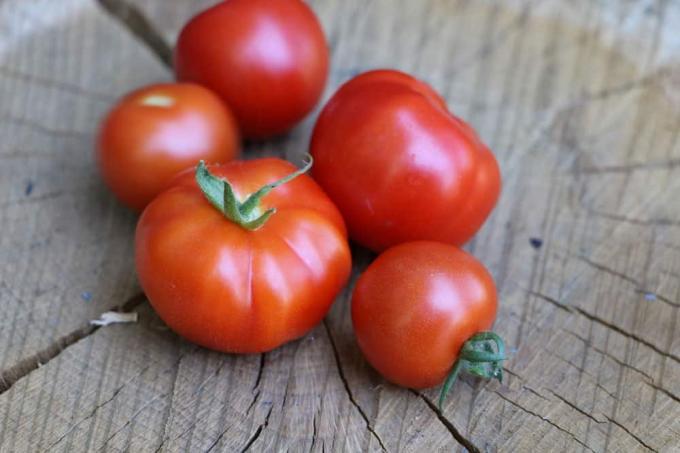
Table of contents
- Location
- tomato varieties
- buy plants
- sowing
- cultivation
- planting/repotting
- substrate
- plant stake
- planter
- Care
- Pour
- Fertilize
- max out
- Diseases
- brown rot
- Brown spots on the fruit
- unripe tomatoes
- Conclusion
Harvesting tomatoes from your own garden not only guarantees freshness; the fruits also taste much more intense and are also not contaminated with pesticides. But not everyone has their own garden. Tomatoes (Solanum lycopersicum) can also be grown in pots on the balcony or terrace. This is quite simple and usually always succeeds if a few important rules are observed.
Location
Whether in the garden or in a bucket, tomatoes love the sun. Even the blazing midday sun cannot harm the nightshade plants. What tomato plants don't like, however, is rain. The location should therefore offer sufficient protection against heavy precipitation and wind. If you don't have a covered balcony, you should at least place the plant close to the wall of the house.
- Light requirements: as sunny as possible
- also tolerates the midday sun
- sheltered from the wind
- rainproof
- warm
tomato varieties
There is an almost infinite number of different tomatoes, which not only differ in color and size of the fruit, but also in their growth behavior.
climbing tomatoes
Climbing tomatoes grow less in width than in height. Their long, slender shoots need to be supported with a stick or trellis. In addition, the plants must be regularly pruned (pinched out) and tied in order to keep their size within limits on the one hand, and to steer them in the desired direction on the other. Climbing tomatoes are very vigorous and are considered to be high-yielding. Unfortunately, they are also prone to disease.
bush tomatoes
Bush tomatoes do not shoot as high as climbing tomatoes. For this reason, you don't really need a climbing aid. Still, they can benefit from it because it keeps the fruit off the ground. Bush tomatoes tend to grow in width and require less care. Also, they are not as susceptible to pests and diseases. However, bush tomatoes do have one disadvantage: their harvest is limited to a short period of time.
buy plants
Pre-grown tomato plants are already available in stores towards the end of April. You can choose between grafted and non-grafted tomato varieties. The selection of tomato varieties is very large. Depending on how much space is available on the balcony, either a bush tomato or a slender but very tall variety should be selected.
sowing

Alternatively, it is of course possible to grow the tomato yourself from seeds. This is particularly useful if you have decided on a tomato variety that is difficult to obtain commercially. From the end of February, the frost-sensitive plants can be placed on a bright window sill.
In deep seed boxes, the young tomato plant develops a thick taproot just like in the garden soil. This long, vertical root not only provides the plant with better stability, but also makes it more resistant to diseases. Plants that have been grown in shallow seed trays do not develop a pronounced taproot, but rather more lateral roots. So if you only need a few tomato plants for the balcony, you should sow the seeds in pots that are as deep as possible.
- Time: from the end of February
- Substrate: poor in nutrients, sterile
- Cactus soil or seed soil
- fill the pots with room-warm substrate
- Lightly press
- moisten with water
- Put one or two seeds on the ground
- cover lightly with sand or fine substrate
- Cover seed pots with lid or plastic bag (prevents excessive evaporation)
- put on the window sill
- Temperature: 15 to 20 degrees
- Keep substrate slightly moist
- air occasionally
- Germination time: about 10 to 14 days
cultivation
After germination, a balance of light and heat is necessary. The temperature must not be too high when the sky is overcast, otherwise the tomato plant will suffer from a lack of light. Under these conditions, weak, pale shoots are formed. This phenomenon is also called "getting lost". In order to support a squat growth with strong, dark green leaves, the plants must therefore be placed a little cooler on dark days. However, the temperature should not fall below 16 degrees. From mid-May, when no more night frosts are to be expected, the tomatoes can go outside. It is best to get your final plant pot beforehand.
planting/repotting
At the beginning of the cultivation, a smaller pot is of course sufficient. However, the planter must be adjusted as the tomato plant grows. Therefore, a regular check of the root ball is necessary. If the fine whitish root network is already visible at the edge of the ball, a larger pot is urgently needed. The material of the planter is irrelevant. First and foremost, it is important that the bucket is large and, above all, deep enough. However, before the plant is potted in the new container, a thick drainage layer must be filled in so that waterlogging does not occur.
- Cover drainage holes with fleece or potsherds
- fill in a drainage layer a few centimeters thick
- Expanded clay or fine chippings are suitable for this
- Mix mature compost or horn shavings under the substrate
- fill in some substrate
- Planting depth: until just before the first leaf base
- in the case of grafted varieties, the grafting point must be above ground level
- fill up with soil
- Press the substrate lightly again and again
- water generously
If the seedlings are planted a little deeper, they will form additional roots from the trunk. This measure also promotes stable and healthy growth of the tomato plant. If there are several tomatoes in a large pot, the planting distance should be around 60 to 80 cm.
substrate
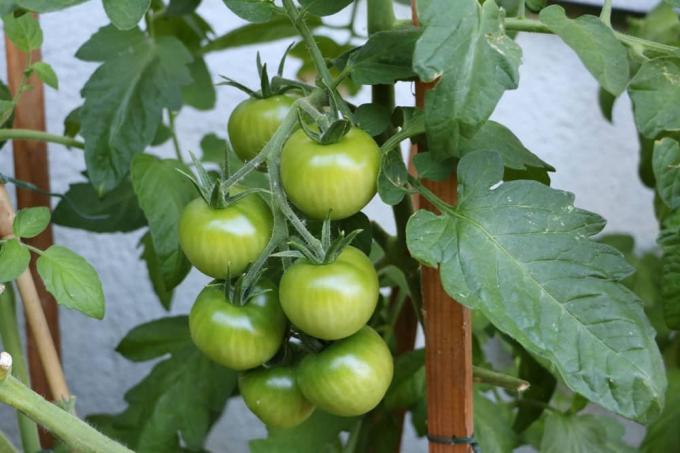
The substrate for a tomato plant should be as nutritious as possible. It is also important that the soil can, on the one hand, drain off the excess irrigation water and, on the other hand, it should also be able to store moisture well. A suitable substrate mixture consists of:
- about 60% of normal potting or garden soil
- 20% mature compost
- 15% leaf soil
- 5% coarse sand or lava granules
Tip:
Leave about two to three centimeters free around the edge of the pot. This pouring rim prevents the water from washing out the soil.
plant stake
With all high-growing tomato species, it is necessary to support the long shoots so that they do not snap off in the wind and fruit load. Therefore, when planting, insert a suitable rod or grid into the substrate. The deeper the plant stake is in the ground, the more stability it offers the plant. Since tomatoes do not climb by themselves, the shoots must be tied to the trellis with a thick string or wire. Make sure there is enough space between the shoot and the stick so that the water and nutrient supply is not cut off as the shoot expands.
planter
One of the most important factors for strong and healthy growth of the tomato plant is a sufficiently large planter. Each individual plant should have at least 15 to 20 liters of volume available for the roots. The tomatoes can also be grown in smaller pots, but in this case they will not grow quite as luxuriantly and have to be watered and fertilized very often.
- choose a sufficiently large planter
- about 20 liters per plant
- with drainage holes
- flat coaster
Care
For a bountiful harvest, tomato plants not only need sun, water and nutrients, they also need a little extra care. This includes pinching the plant at regular intervals. An exception to this are vine tomatoes and bush tomatoes, which naturally grow with plenty of branching. You are usually allowed to spread to your heart's content.
Pour
Tomatoes are very thirsty plants. The higher the outside temperatures rise, the more water they need. On hot days, the nightshade plants must be watered at least in the morning and evening. It is best to leave some water in the saucer on these days so that the roots can absorb it later. Otherwise, the tomato plant must always be watered when the upper layer of substrate has already dried.
The plant does not tolerate waterlogging at all. A clear sign that the plant is suffering from a lack of water is drooping leaves. In this case, it is urgently necessary to water generously, otherwise the flowers and fruits will be thrown off. However, avoid watering the leaves. Because if the leaves get wet, brown rot can form.
Tip:
While regular watering ensures strong plants and fruit, hobby gardeners who water infrequently but a lot risk the fruit bursting or getting a very hard skin.
Fertilize
Tomatoes are also one of the most demanding plants when it comes to nutrients. Tomatoes are heavy feeders and therefore need significantly more fertilizer than other plants. Therefore, provide nutrients at regular intervals. But even if the plants like extremely nutrient-rich soil, you should not overdo the fertilizer application. If the amount of nitrogen is too high, leaf growth is promoted and the fruit suffers. In addition to organic long-term fertilizers, special tomato fertilizers are of course also suitable, which should be dosed according to the manufacturer's instructions.
- special tomato fertilizer
- vegetable fertilizer
- horn shavings or horn meal
- other organic slow-release fertilizers for vegetable crops
Tip:
Fertilize the tomatoes with compost or horn shavings when planting them in the bucket. Always work solid fertilizers into the soil.
max out
In order for the plants to bear a lot of fruit, new side shoots that form in the leaf axils must be broken out regularly. With the so-called Ausgeizen all shoots that form between the leaf stalks and the main stem are removed. Some varieties of tomatoes also tend to develop new leaves behind the fruit shoots. These must also be removed. Only in this way does the tomato put its energy into the fruit and not into the formation of new leaves. The lower leaves may be in contact with the ground.
To prevent rot, it makes sense to cut them off. Towards the end of August all new flowers are removed. Since the tomatoes will not ripen in the short time before the end of the tomato season, the plant can put all its energy into the fruits that are already there. Although bush tomatoes do not have to be pinched, you should still make sure that there is enough light everywhere in the plant. The leaves must also be well ventilated and be able to dry quickly so that rotting diseases do not occur. A light thinning is therefore good for the tomato plant.
Diseases
Many tomato diseases, such as leaf and infectious diseases, can be avoided by providing the plant with protection from the rain. This is not a problem on covered balconies, because the plant only has to be placed in a rain-protected place. On uncovered balconies and roof terraces, a roof or a tomato house is useful as a preventive measure. In addition, tomato plants must always be watered from below, i.e. never over the leaves.
brown rot

The most feared disease affecting tomatoes is brown rot. This disease is caused by a fungus that can spread over long distances with its spores. First, black-brown spots can be seen on the leaves, later the fruits are also infected. Infected plants can usually no longer be saved. To prevent spread, brown leaves must be removed immediately and disposed of with household waste. Fruits that are not diseased can be harvested and ripened indoors. The risk of brown rot is highest in warm, humid weather. In contrast to the field, tomatoes on a well-protected balcony are better protected against brown rot. Nevertheless, it can also occur when cultivating on the balcony.
Brown spots on the fruit
Sometimes tomatoes have brown discoloration where they attach to the plant. This is either a sign of a lack of calcium. This deficiency occurs when there are too few calcium salts in the soil. On the other hand, an increased concentration of other nutrient salts (such as potassium, magnesium or sodium) can also impede the absorption of calcium. You can prevent the formation of brown spots on the fruit by keeping the soil as evenly moist as possible. If a nutrient deficiency is probable (fertilized too little or not at all), a special calcium fertilizer sprayed on the leaves can help.
unripe tomatoes
The tomato plants do not get enough sun every year, which they need to let the fruit ripen. A large number of unripe fruits are often still hanging from the plant when the days in September are slowly getting cooler. But these fruits are not lost yet. As soon as the tomatoes turn slightly orange, they can be picked and left to ripen indoors.
Conclusion
It's not that difficult to grow tomatoes on the balcony. In addition to plenty of sunshine, the most important prerequisite for healthy growth is a sufficiently large planter and protection from rain. In order for magnificent tomato fruits to form, hobby gardeners have to pinch, fertilize and evenly water their tomato plants. Then nothing stands in the way of a rich harvest.
 garden editorial
garden editorial I write about everything that interests me in my garden.
Learn more about tomatoes
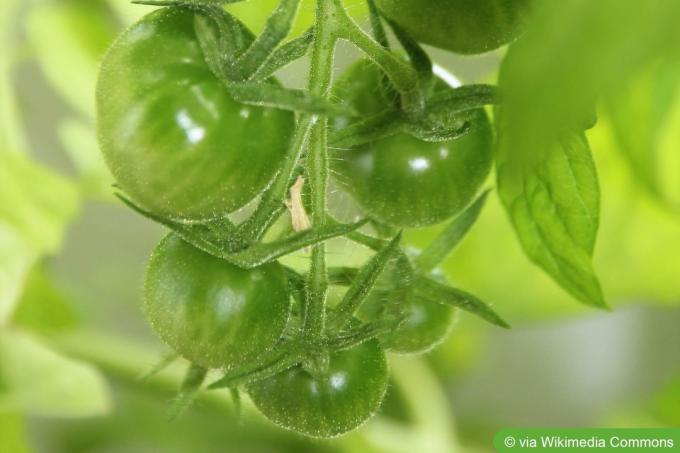
Mexican Honey Tomato: Taste & Cultivation
With the "Mexican honey tomato", hobby gardeners can bring a particularly sweet tomato variety into their garden. Due to its low acidity, it is one of the most popular sweet tomatoes and at the same time very easy to care for.
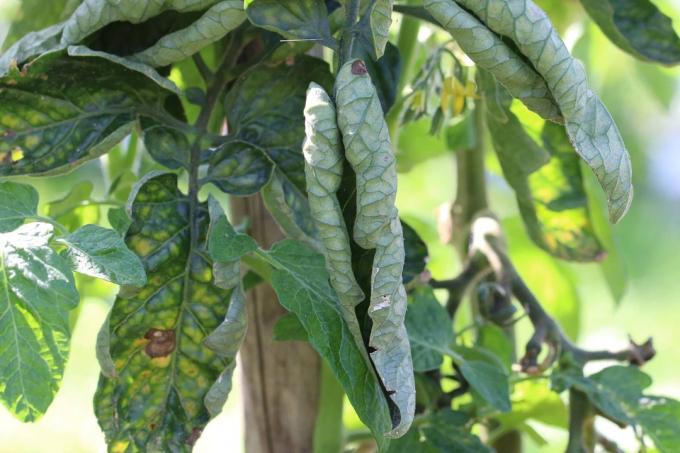
Tomato leaves curl: what to do?
There are many causes of curled leaves on tomato plants. Some are harmless, others can ruin crops. So waiting is not an option. Like a detective, you must search for clues. And then, if feasible, tailor-made countermeasures. Here's what to do when tomato leaves curl.
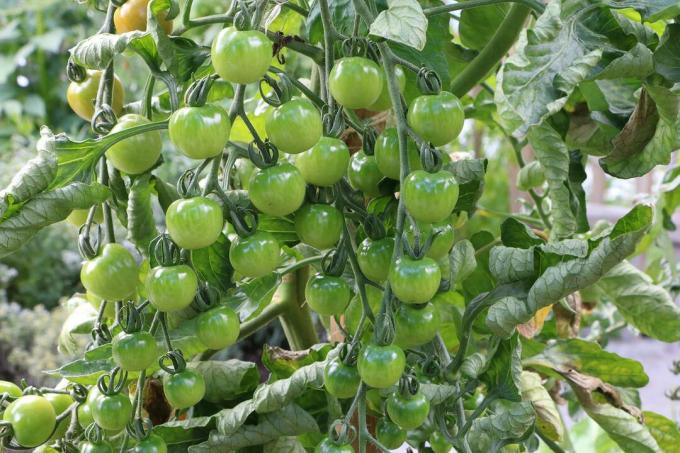
Fertilize tomatoes: how often, when and with what?
Tomatoes need a consistently high amount of nutrients for the development of flowers and fruits. In addition to choosing the right fertilizer, the amount and frequency also play an important role. All essential information for an optimal dosage can be found here.
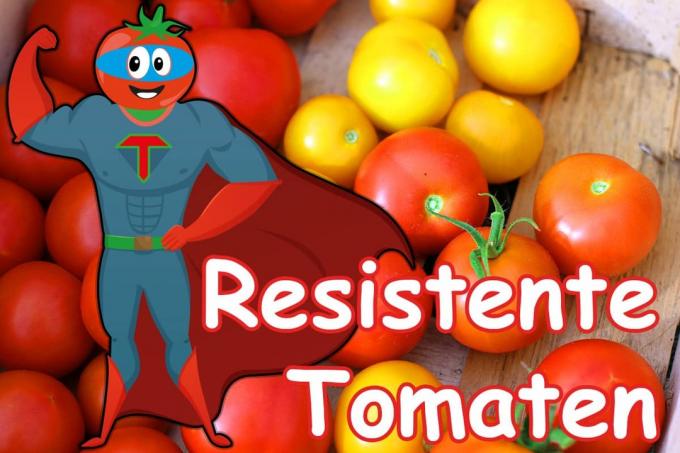
11 resistant tomato varieties defy rain and disease
Tomatoes are considered to be relatively easy to care for, but rain and numerous diseases can bother them. Fortunately, there are numerous tomato varieties that are resistant to many dreaded tomato diseases. We present the most popular specimens in this article.
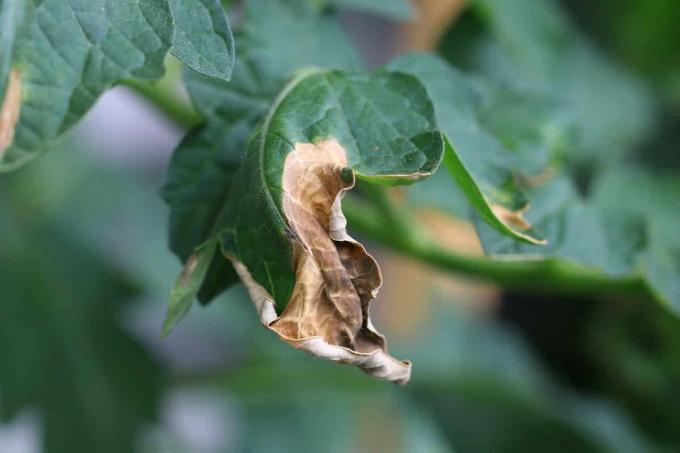
Control late blight and late blight in tomatoes
If pathogens of brown blight and late blight have settled on tomato plants, there is little hope of successful control. Home remedies and mechanical interventions only make sense in the early stages. It is all the more important that you prevent infections in a targeted manner through care measures.

How healthy are tomatoes? Information on calories, nutritional values & Co.
Snack healthy? The tomato makes it possible! Find out here why the red fruit should end up on the plate more often!

